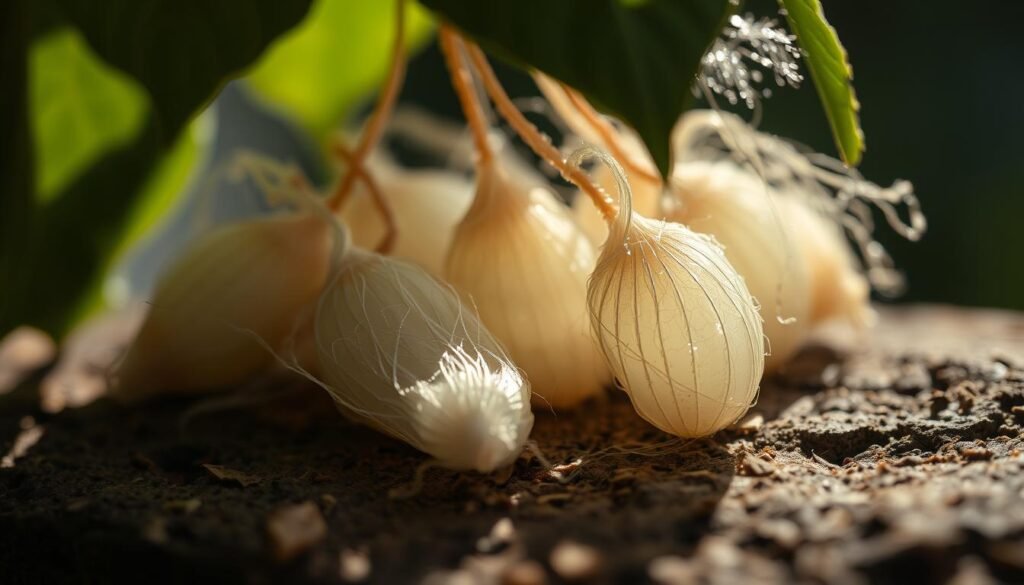Silk is a luxury fiber known for its shine, softness, and strength. But, making traditional silk kills billions of silkworms every year. They are boiled or steamed alive to get the silk fibers from their cocoons1.
This raises big questions about animal welfare and the silk industry’s future. As people think more about the impact of their clothes, they wonder: Is silk really kind and green? Let’s look into the complex truth of silk making and the big ethical issues it brings up.
Key Takeaways
- Silk production kills millions of silkworms every year to get the silk fibers.
- Child labor is found in the silk industry, with kids as young as 5 forced to work.
- “Peace silk” or “ahimsa silk” claims to be cruelty-free, but it’s not always true. Real silk is often wrongly called this.
- There are other fabrics like nylon, polyester, Tencel, and bamboo silk that are kinder to animals and better for the planet.
- Knowing the ethical side of silk making helps us make better choices for our clothes.
The Luxury of Silk: A Historical Perspective
Silk has a long history, starting in ancient China. It’s known for its beauty, strength, and softness. This made it a sign of wealth and status in old Rome and Arabia2.
Back then, silk was so valuable it was used as money. Its weight was like gold’s2. The Silk Road, a network of trade routes, helped spread silk across the world. It changed global trade and culture for many years2.
Silk’s Ancient Origins and Global Trade
The Chinese kept silk production a secret for a long time. They wanted to keep their control on this valuable fabric. It wasn’t until the 6th century AD that others learned how to make silk2.
This spread of silk changed the world. It made new connections and helped different cultures meet2.
Now, silk is still a top choice for luxury fabrics. China makes most of the world’s silk3. But, the way silk is made today is facing criticism. Silkworms are killed to get their cocoons. This has led to the creation of Ahimsa silk, a kinder option.
“Silk has been prized for its beauty, durability, and comfort for over a thousand years, particularly among Roman and Arabian aristocrats.”
The Silkworm: Nature’s Remarkable Weaver
Silk comes from the larvae of certain moths, like the mulberry silkworm, Bombyx mori4. These insects make cocoons to protect themselves as they change into moths. This process is both amazing and raises big questions about ethics.
Each silkworm can make up to 915 meters of silk in just 3 days4. The silk business is huge, with China leading and India second, making about 90% of the world’s silk4.
There’s more than just mulberry silk. For example, Eri silk comes from worms eating castor plants, and Tussar silk is wild silk from North India’s forests4. Ahimsa silk, or “peace silk,” is made without hurting the worms, letting them turn into moths first5.
The silk market is expected to grow to $16.94 Billion by 20215. But, making silk the old way kills silkworms4. Now, people are looking at Ahimsa silk and plant-based silk as better choices, caring more about the planet and animals5.
As silk demand goes up, we see the silkworm as a complex symbol. It shows we need to think about making silk in a way that’s good for everyone and the planet.
Traditional Silk Production: A Cruel Process
The traditional way of making silk is hard work and raises big ethical questions6. Silkworms are raised in special places and then killed to get the silk from their cocoons. It takes about 6,600 silkworms to make just 1 kilogram of silk6.
Sericulture: Harvesting Silkworm Cocoons
Sericulture is the art of raising silkworms for silk6. It’s a big job that employs 1 million people in China and helps many families in India and Thailand6. But, it’s also linked to child labor, with kids as young as five working long hours7.
This process uses a lot of water, energy, and land7. It also needs mulberry trees, which can be grown with harmful chemicals, harming the environment7.
| Metric | Quantity |
|---|---|
| Silk’s share of the global fiber market | Less than 0.2%67 |
| Number of cocoons required for 1 yard of silk fabric | Approximately 3,0006 |
| Mulberry leaves yield per hectare | Approximately 11.25 tons, leading to 200 kg of cocoons and 40 kg of raw silk6 |
| Silkworms killed for 1 kg of silk | Approximately 6,6006 |
| Silkworms killed for 1 pound of raw silk | Approximately 2,5007 |
| Silkworms killed for 1 silk shirt | Approximately 1,0007 |
This traditional way of making silk is very worrying because it involves killing silkworms67. We need to find better ways that don’t harm animals.

Are Silkworms Killed to Make Silk Fabric? Ethical Considerations
The making of silk fabric has sparked ethical debates. It needs the death of billions of silkworms8. Silk is loved for its softness and strength. But, the way it’s made worries animal lovers and those who care about doing the right thing.
Silk making, or sericulture, grows and harvests silkworm cocoons8. It takes 5,500 silkworms to make just 1 kilogram of silk8. This shows how many silkworms are killed for silk.
The silk industry also harms the environment8. It needs 187 kilograms of mulberry leaves for 1 kilogram of silk8. This shows how silk making is bad for the planet.
There are also problems with how people are treated in the silk industry9. In places like Uzbekistan and India, people are forced to work hard and face health dangers9.
More people now want silk that doesn’t hurt animals or the planet9. New kinds of silk, like peace silk and vegan silk, are being made from plants9.
The silk industry kills many silkworms, causing an ethical problem. Silk is still very popular, but making it is being watched closely. As more people want silk that’s kinder to animals and the earth, the silk industry must change.
The Vegan Dilemma: Is Silk Truly Cruelty-Free?
Traditional silk making is a big issue for vegans. Silk is seen as fancy but not vegan-friendly. Vegan silk, or cruelty-free silk, is now more popular as people look for ethical fashion.
Why is this a problem? Making silk kills silkworms. It takes 1,000 silkworms to make just one silk shirt10. For 1 kg of silk, 6,600 silkworms die10. This is why vegans don’t like silk.
Some say they have “cruelty-free” or “peace silk” but it’s not always true. Peace silk still kills hundreds of caterpillars per cocoon10. Vegans don’t trust these silk alternatives.
But, there are good options for vegans and those who care about the planet1011. Fibers like Tencel Lyocell and modal are luxurious but don’t harm animals.
As more people want ethical fashion, the silk debate will keep going. Choosing between silk and vegan silk depends on what you believe in1011.
| Silk Production Statistics | Data |
|---|---|
| Silkworms killed per silk shirt | 1,00010 |
| Silkworms killed per 1 kg of silk | 6,60010 |
| Annual silk production in China | 130,000 metric tons11 |
| Annual silk production in India | 30,000 metric tons11 |
| Global annual silkworm deaths | 10 billion11 |
“The entire life cycle of a silkworm, from egg to mature moth, takes about 6-8 weeks.”11
Ahimsa Silk: A Cruelty-Free Alternative?
The silk industry is facing big ethical issues. Ahimsa silk, or ‘peace silk,’ is a new way to make silk that’s kinder to silkworms. It lets them live their full life before taking their silk.
Exploring the Ethics of ‘Peace Silk’
Before, making silk meant boiling silkworms alive. This was very cruel12. Ahimsa silk tries to be better by not doing this. It uses different kinds of silkworms like eri, tussar, and muga12.
But, some people question how kind ahimsa silk really is. Even though the worms don’t get boiled, they might still face bad treatment. The silk made this way is also not as good as before12.
There are other silk-like materials like lotus, cactus, pineapple, and banana silk12. These options are good for animals and the planet. They show the fashion world can be kinder, thanks to people wanting change12.
| Silk Type | Production Details | Environmental Impact |
|---|---|---|
| Traditional Silk | Involves boiling silkworms alive, causing harm and suffering12 | Ranks high on the Higg Materials Sustainability Index for its environmental impact13 |
| Ahimsa/Peace Silk | Aims to be more ethical by allowing silkworms to complete their natural life cycle, but practices vary among manufacturers12 | Organic production avoids the use of fertilizers and pesticides13 |
| Vegan Silk Alternatives | Lotus, cactus, pineapple, and banana silk offer cruelty-free options12 | Global Recycle Standard (GRS) certification verifies genuine recycled content in silk fabric13 |
Finding ethical and green ways to make silk is hard. We all need to work together. Consumers, brands, and everyone in the industry must find ways to help silkworms and the planet12.

“The journey towards ethical fashion requires a collaborative effort between consumers, brands, and the entire industry. Only through this collective commitment can we ensure that the luxury of silk is not tainted by the suffering of its creators.”
The Hidden Cost: Worker Exploitation in the Silk Industry
The silk industry has big ethical problems that go beyond how they treat silkworms. In places like China and India, workers, even kids as young as 5, face bad work conditions and low pay14. They work long hours and may be in debt or forced to work, all for making silk14.
People want more silk, which makes things worse. India’s silk industry makes a lot of money, but the workers barely get by.14
Bad practices in the industry have led to less silk being sold in India. From $380 million in 2008 to just $155 million in 201314. This shows we need better rules and protection for silk workers.
“The fashion industry plays a significant role in human rights abuses, including child labor and sweatshops, with notable incidents like the Rana Plaza garment factory collapse in Bangladesh in 2013.”15
As people learn more about the impact of their choices, the silk industry must change. They need to make sure silk is made right, with fair work conditions.
Innovative Solutions: Cruelty-Free Silk Alternatives
The fashion world is changing, and people want ethical and green choices instead of traditional silk. Luckily, new solutions are here. They don’t harm silkworms and are luxurious, work well, and good for the planet. These cruelty-free silk alternatives are becoming popular as more people choose cruelty-free silk alternatives, sustainable textiles, and ethical fashion.
Sustainable and Ethical Fiber Options
Peace silk, also known as Ahimsa silk, is a great choice instead of traditional silk. It lets silkworms finish their life cycle, so they don’t die for silk. This way, it’s kinder and the silk feels softer and shinier16.
There are many other new materials that are becoming cruelty-free silk alternatives. These include fibers from yeast and sugar16, lotus flowers, bamboo, oranges, ramie, and eucalyptus17. These options are kinder to silkworms and are as luxurious and good as silk but better for the earth.
| Cruelty-Free Silk Alternatives | Key Features |
|---|---|
| Peace Silk (Ahimsa Silk) | Harvested in a way that allows silkworms to complete their life cycle; softer, more lustrous texture than conventional silk |
| Yeast and Sugar-Based Silk | Innovative material that avoids the use of silkworms; potential to rival the luxury and performance of traditional silk |
| Lotus Flower Silk | Naturally occurring fiber extracted from the stalks of lotus flowers; biodegradable and environmentally friendly |
| Bamboo Silk | Derived from the fast-growing and renewable bamboo plant; soft, durable, and hypoallergenic |
These new options solve the ethical problems of traditional silk and offer green choices that are getting popular. By picking these cruelty-free silk alternatives, people can help make the fashion world better for everyone16.
“The future of fashion lies in innovative, sustainable, and ethical solutions that prioritize the well-being of all living beings and the planet. Cruelty-free silk alternatives are a shining example of this shift towards a more conscious and responsible industry.”
The Future of Ethical Fashion
More people now know about the ethical and environmental issues with the silk industry. This has led to a big push for conscious and sustainable fashion choices. Designers, brands, and buyers are looking for cruelty-free, animal-friendly, and socially responsible alternatives to traditional silk and other animal products18. The future looks bright for ethical fashion, with new solutions and a focus on making the industry better for people and the planet.
Sustainable textiles are becoming a big deal in ethical fashion. Brands are now using peace silk, which lets the silkworm emerge before taking the cocoon18. They’re also looking at wild silk, which is better for the planet and animals than regular silk19.
More people want ethical fashion because they care about the planet and its people. They’re choosing brands that focus on being sustainable and ethical1819.
| Sustainable Fiber Options | Environmental Impact |
|---|---|
| Organic Cotton | Uses less water and energy, no synthetic pesticides |
| Hemp | Needs less water, no pesticides, and breaks down easily |
| Bamboo | Grows fast, uses fewer resources, and breaks down easily |
| Recycled Polyester | Uses less waste and energy than new polyester |
The ethical fashion movement is growing fast. New ways to make textiles and conscious consumerism will help shape a better fashion industry1819.
“The future of fashion is not about trends, it’s about creating a better world.”
Conclusion
Traditional silk fabric making is linked to the death of billions of silkworms yearly20. Silk has been valued for a long time. But, its making is now seen as cruel. Luckily, there are now silk alternatives that are kinder and better for the planet.
The silk industry harms the environment too. It uses a lot of energy and water, making it worse for the planet20. Cotton farming also uses too many pesticides and water, hurting nature and people’s health21.
As people want more ethical fashion, the silk industry must change20. They need to be kinder to animals and the earth. People are looking for silk that is made without harming others and is good for the planet.
FAQ
What is the traditional silk production process and how does it involve the killing of silkworms?
Silkworms are raised in special places and then boiled or steamed alive to get silk. This kills them. It takes about 6,600 silkworms to make just 1 kilogram of silk. This makes people question the ethics of using silk.
What is the historical significance and value of silk?
Silk has been around for thousands of years, starting in ancient China. It was very rare and valuable, making it a key item on the Silk Road. Silk was so valuable it was sometimes used as money. It showed wealth and status in places like Rome and Arabia.
What are the remarkable features of silkworms as natural weavers?
Silkworms, especially the mulberry silkworm, make silk. They spin cocoons to protect themselves as they change into moths. In just 3 days, one silkworm can make up to 915 meters of silk, showing how amazing they are.
What are the ethical concerns surrounding the traditional silk production process?
Killing silkworms for silk is a big issue. Many people think it’s wrong to use so many animals for luxury. Animal welfare groups and some consumers want better, kinder ways to make silk.
Is silk considered vegan, and what are the concerns around “cruelty-free” or “peace silk” alternatives?
Silk isn’t vegan because it comes from animals that are killed. Veganism means not using any animal products or byproducts. Some silk is called “cruelty-free” or “peace silk,” but it’s hard to know if it’s really better for the worms.
What are the ethical concerns beyond the treatment of silkworms in the silk industry?
There are more ethical problems with silk. In places like China and India, people, even kids, are treated badly. They work long hours for little pay, often being forced to work off a debt.
What are some innovative and cruelty-free alternatives to traditional silk?
There are new, kinder ways to make silk-like materials. These come from yeast, sugar, lotus flowers, bamboo, oranges, ramie, and eucalyptus. These options are better for the environment and don’t harm silkworms.




